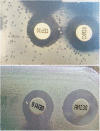Bacteriophages in clinical samples can interfere with microbiological diagnostic tools
- PMID: 27609086
- PMCID: PMC5016790
- DOI: 10.1038/srep33000
Bacteriophages in clinical samples can interfere with microbiological diagnostic tools
Abstract
Bacteriophages are viruses that infect bacteria, and they are found everywhere their bacterial hosts are present, including the human body. To explore the presence of phages in clinical samples, we assessed 65 clinical samples (blood, ascitic fluid, urine, cerebrospinal fluid, and serum). Infectious tailed phages were detected in >45% of ascitic fluid and urine samples. Three examples of phage interference with bacterial isolation were observed. Phages prevented the confluent bacterial growth required for an antibiogram assay when the inoculum was taken from an agar plate containing lysis plaques, but not when taken from a single colony in a phage-free area. In addition, bacteria were isolated directly from ascitic fluid, but not after liquid enrichment culture of the same samples, since phage propagation lysed the bacteria. Lastly, Gram-negative bacilli observed in a urine sample did not grow on agar plates due to the high densities of infectious phages in the sample.
Figures





References
-
- Adams M. H. In Bacteriophages 592 (1959).
Publication types
MeSH terms
LinkOut - more resources
Full Text Sources
Other Literature Sources
Medical

